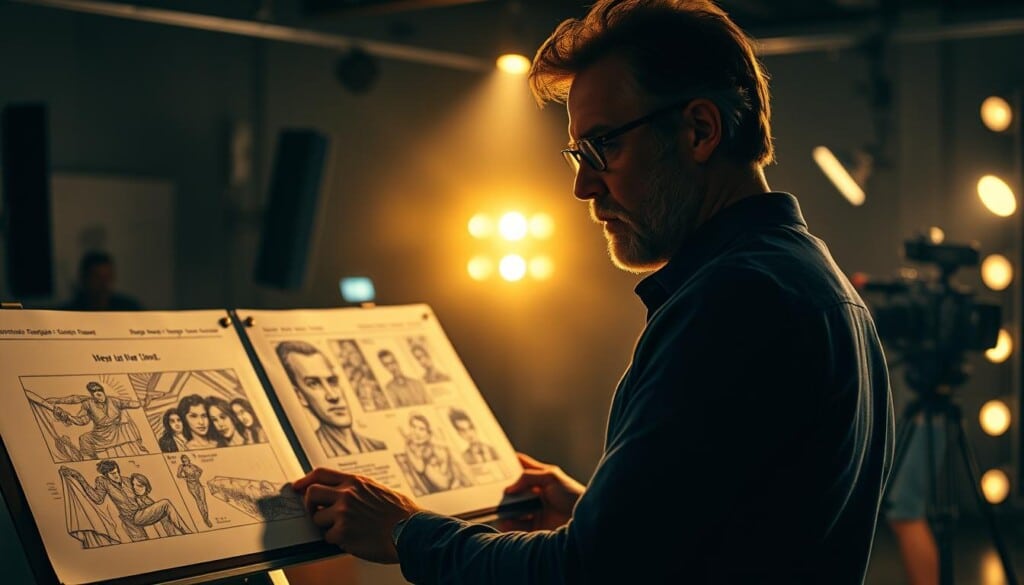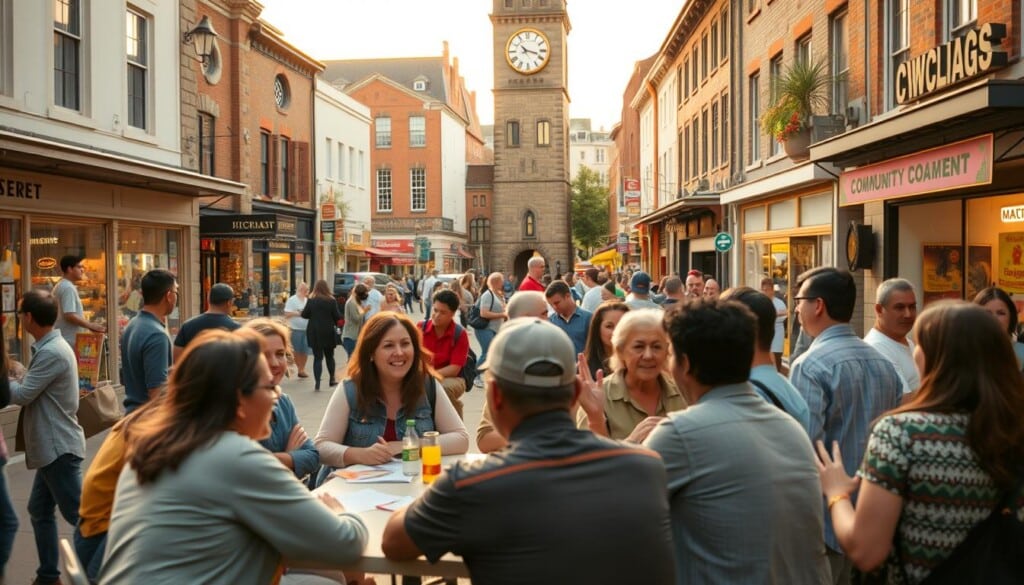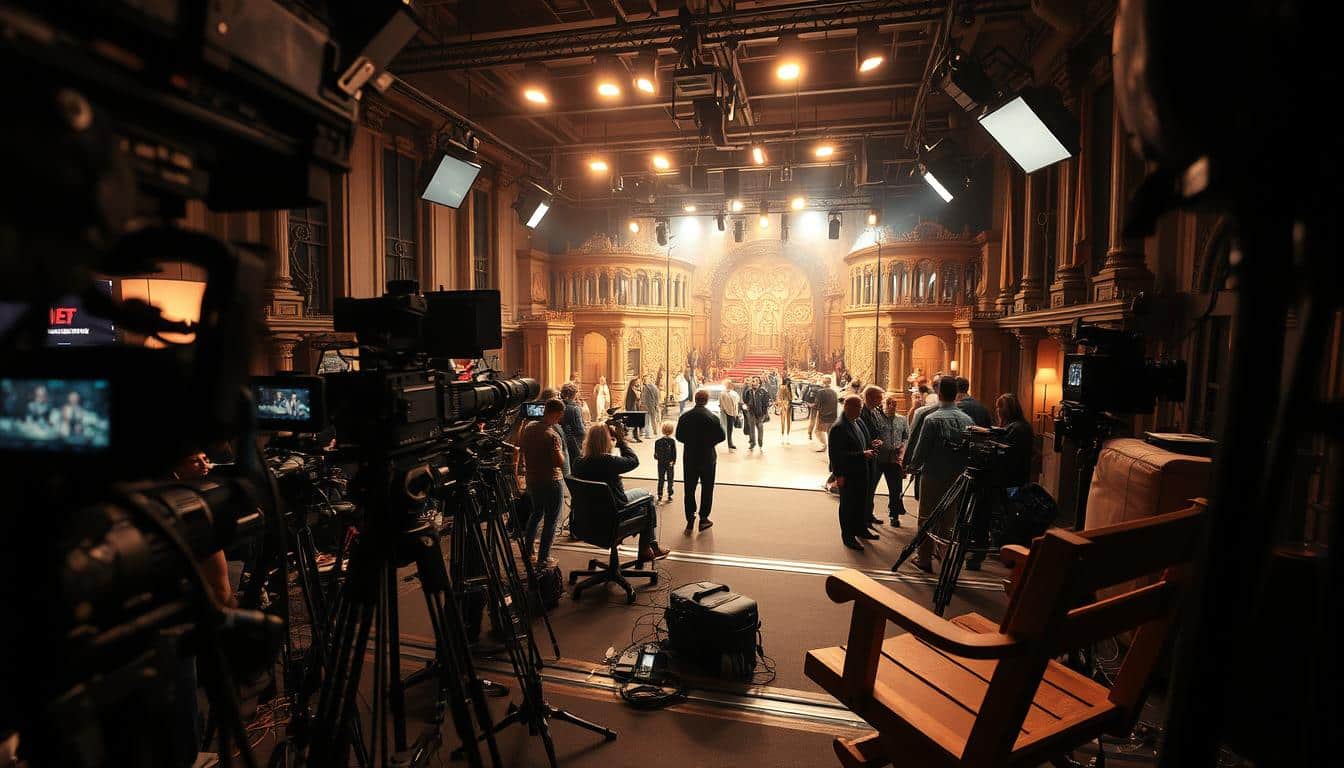Ever wondered why some movies are huge hits while others are forgotten? The secret lies in balancing creativity with technical skills in film production. This guide will help you improve your movie making, whether you’re new or experienced. We’ll cover everything from the first idea to the final edit, focusing on the art and science of making films.
Key Takeaways
- Understanding the critical stages involved in film production enhances overall effectiveness.
- Pre-production planning is essential for a successful filming experience.
- Utilizing local resources can lead to a more authentic movie-making environment.
- Mastering cinematography techniques significantly impacts the quality of your film.
- Effective marketing strategies can elevate your film’s visibility and success.
- Leveraging community connections, like those offered by LocalZ, can lead to fruitful collaborations.
Understanding the Basics of Film Production
Film production is a complex process that turns a creative idea into a real movie. A skilled film producer oversees the production. They make sure everything fits the vision and budget of the production company.
The producer manages resources, coordinates the crew, and guides the project. They help it reach its goal of success.
The Role of a Film Producer
The film producer is the heart of the production. They find funding, hire key people, and keep everyone talking. They make sure the project stays on schedule and budget.
They also help the team work together to bring the script to life.
Key Stages of Film Production
Film projects go through three main stages: pre-production, production, and post-production. In pre-production, they plan the script, find locations, and get the crew ready.
During production, they capture the footage. This is where planning and doing come together. Post-production is all about editing, improving visuals, and adding sound.
Essential Equipment for Filmmaking
Good filmmaking needs the right equipment. This includes cameras, lights, mics, and editing tools. Each piece is important for quality visuals and sound.
Knowing your equipment well helps the crew work better. It makes the movie a hit.
Crafting a Strong Film Concept
Creating a solid film concept is the first step to a great movie. A good story grabs the audience’s attention. It has clear conflicts and a goal for the main character.
This makes the story engaging and sets the stage for character growth.

Developing Your Storyline
A well-made storyline keeps viewers hooked. It should have challenges for the main character. This makes the audience care about their journey.
Having a clear main conflict and stakes keeps viewers interested. It makes the story more exciting.
Creating Characters That Resonate
Characters are key in a story. By making them relatable and complex, filmmakers connect with the audience. Characters who grow and face challenges touch viewers’ hearts.
This makes the movie more impactful.
The Importance of Pre-Production Planning
Effective pre-production planning is key to a successful film project. It starts with careful budgeting, making sure money is used wisely. A good budget helps the team make smart choices and avoid spending too much.
Building a skilled production team is also vital. This team includes directors, cinematographers, and designers, each bringing their own skills. A united team works better together, creating a space for creativity and efficiency.
Good scheduling and time management are essential for filming. A realistic timeline helps the team work efficiently without delays. Using strategies like setting milestones and regular checks keeps the project moving smoothly.
Utilizing Local Resources for Filmmaking
Using local resources can really help with filmmaking. Filmmakers should look around their community for unique places to film. These spots can add interest to the film and save money.
It’s also key to find local talent and crew. People from the area bring special knowledge and skills. This can make the film better. Sites like LocalZ help find these resources, making sure the film gets the support it needs.
Filming Techniques to Elevate Your Production
Mastering filming techniques is key to creating a compelling story. The choices in camera angles and shot compositions affect how we see a story. Using these elements well can make the story more emotional and engaging, helping filmmakers share deeper meanings.
Camera Angles and Shots Explained
Different camera angles change how we see scenes. Low angles make characters seem powerful, while high angles make them seem less so. Shot types like close-ups and wide shots help tell the story by showing emotions or setting the scene. Knowing these angles is important for making films that connect with viewers.
Lighting: Setting the Right Mood
Lighting is vital in setting a film’s mood. Using key, fill, and backlighting can change a scene’s feel. For example, harsh lighting can create tension, while soft light suggests closeness. Understanding lighting is key to improving a film, making it more engaging and setting the right tone.
Post-Production Workflow
The post-production phase is key in filmmaking. It turns raw footage into a final, polished film. This stage includes editing and sound design, which are vital for a great viewing experience.
Editing Essentials for a Polished Film
Editing is the heart of post-production. It needs a clear workflow to make the story and visuals flow well. The process involves cutting footage, adding transitions, and adjusting the pace to improve the story.
Every editing choice helps shape the film’s structure. It keeps viewers hooked from the beginning to the end. A well-edited film tells the story well and takes the audience on an emotional journey.
The Role of Sound Design in Film
Sound design is also critical in post-production. It adds depth and resonance to the film. Audio elements like clear dialogue, sound effects, and background scores create an immersive atmosphere.
The right sound choices enhance the emotional impact of scenes. They guide how viewers react and improve the story experience. Paying attention to sound design makes the film memorable for the audience.

Marketing Your Film Effectively
Getting your film noticed is key to its success. A strong online presence helps connect with viewers. Using different marketing strategies boosts visibility and engagement.
Creating content that speaks to viewers can make a big difference. Tailoring your marketing approach helps attract interest and build excitement.
Building a Strong Online Presence
A solid online presence showcases your film’s heart. Websites and portfolios offer a peek into the project, casting, and making of the film. SEO helps people find your film easily.
Sharing stories through blogs and updates builds a community. This keeps audience interest alive over time.
Utilizing Social Media for Promotion
Social media is a great way to promote your film. Share trailers and behind-the-scenes clips to keep people interested. Talking to your followers helps you understand what they like.
Running contests or live Q&A sessions can create excitement. This encourages people to share your content, reaching more viewers.
Collaborating with Local Businesses Through LocalZ
Working with local businesses makes filmmaking better. It opens up new ways to connect with the community. LocalZ helps filmmakers find local businesses looking for sponsorship deals.
These partnerships are good for everyone. Businesses get more visibility, and they help support the arts.
Engaging the Community with Your Film
Getting the community involved makes your film more special. By teaming up with local businesses, you can create events that really speak to people. This approach helps build strong community ties and boosts support for your film.
Finding Sponsors & Partners
LocalZ is a great tool for finding sponsors and partners. It connects filmmakers with local businesses that share their vision. This way, filmmakers can get funding and also benefit from marketing together.

Hosting Local Screenings and Events
Hosting local screenings is key for filmmakers to connect with their audience. It helps build community engagement. The first step is choosing the right venue. The venue can make or break the experience.
The right venue not only looks good but also fits the film’s theme. It provides a perfect setting for the story.
Choosing the Right Venue
Many factors are important when picking a venue. Accessibility is a top priority. It ensures everyone can come.
Other things like seating, sound quality, and atmosphere matter too. They should match the film’s message. Local theaters, community centers, and outdoor spots are great options if they improve the viewing experience.
Promoting Your Film Locally
Promoting your film well is key to getting people to come. Use local channels like bulletin boards, social media, and the press. This creates excitement around the event.
Highlighting how the film relates to the local audience boosts community involvement. It makes the film more visible and benefits both the film and its viewers.
Raising Funds for Film Projects
Getting money for films is key. Filmmakers look at many ways to fund their projects. Crowdfunding lets them reach out to fans for help. Traditional investors give more money but want something back.
Knowing the differences helps filmmakers choose the right path for their project.
Crowdfunding vs. Traditional Investors
Crowdfunding is popular for new filmmakers. Sites like Kickstarter and Indiegogo help them share their ideas. This way, many people can help out.
But, traditional investors expect to make money. They give more money but have strict rules. It’s important to know the pros and cons of each.
Leveraging LocalZ’s Community Connection
LocalZ helps filmmakers find local funding. Working with the community can bring in support. This way, filmmakers can get help from people who care about local talent.
Using LocalZ also helps grow the creative community. It’s a win-win for everyone.
The Future of Film Production in Your Area
The world of film production is always changing. It’s key for filmmakers to know about future trends to succeed in local filmmaking. Trends like more diverse stories and digital media use change how we tell and make movies.
Filmmakers need to use these trends in their work. This way, they can connect with their audience and stay relevant.
Trends Influencing Local Filmmaking
Local filmmaking is seeing big changes, like more community involvement. Filmmakers using local resources can work with local businesses and talent. This makes their films more connected to their audience.
It’s also important to tell stories that show community values. This helps local film industries grow.
Embracing Technology in Film Production
Technology is key in making films better and more creative. Using new tools like advanced editing software and virtual production helps tell stories in new ways.
By using these technologies, filmmakers can make high-quality movies. They can also save money and resources, making them more competitive.

